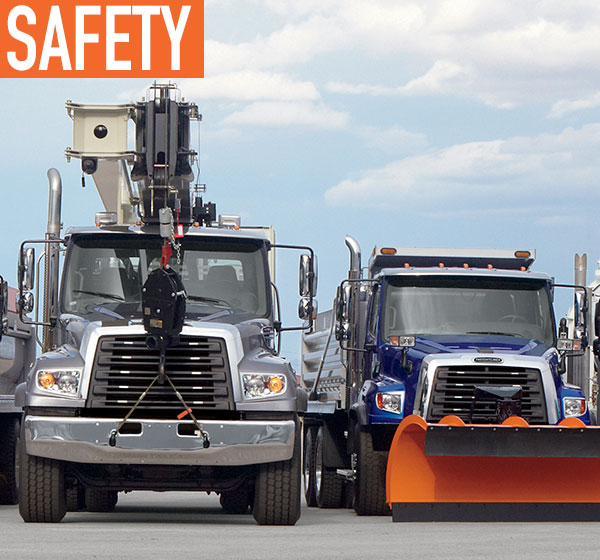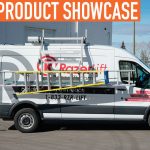Vocational truck fleets are showing interest in safety systems. While initially designed for highway driving, these advanced safety systems are adapting for use in the very different environments of vocational trucking: congested streets, road construction, pedestrian traffic, crowded worksites, numerous stops and starts, etc.
Vocational fleet managers find that safety systems provide an extra level of comfort with less experienced drivers and sometimes serve as a driver recruitment tool.
Customers are making the investment to potentially mitigate preventable accidents that can hurt their productivity. While usually less serious than on-highway accidents, even “minor accidents” that are more characteristic of vocational trucking—such as a low-speed, rear-end collision with another vehicle that can damage a truck’s bumper, radiator, aftercooler, hood, headlight assemblies, tires, and wheels—can be costly. From repairs, replacement vehicle rentals, and lost time on the job, that “minor accident” with no personal injuries can be very expensive.
IN THE STATS
Vocational fleet managers are motivated to spec safety systems because of the positive results on-highway fleets experience with them. Those fleets’ initial investments show returns in increased uptime and productivity due to fewer and less severe accidents.
A 2016 field study by the National Highway Traffic Safety Association examined 6,000 collision mitigation system (CMS) activations from more than 3 million miles to evaluate the reliability of the systems. It concludes: “No sampled activations were associated with collisions, and companies did not report any rear-end collisions involving the vehicles in the study … Overall, (CMS) technologies show potential for significant safety benefits for commercial vehicle drivers.”
Additionally, according to Meritor WABCO, fleets that use its CMS reported up to 87 percent fewer rear-end collisions and up to an 89 percent reduction in rear-end collision costs. While those findings relate to on-highway driving, there is great potential that safety systems can produce positive results for vocational applications, too.
CMS
At the heart of many new safety systems is CMS, which uses a combination of forward collision warning, active braking, and adaptive cruise control to prevent or mitigate accidents.
A typical CMS employs a spectrum of forward-looking radars to detect objects in the vehicle’s path, both moving and stationary. The most advanced systems provide audible, visual, and haptic warnings, as well as automatically reduce engine torque and apply the foundation brake if necessary. To support CMS systems, vocational OEMs offer optional air disc brakes with advanced anti-lock braking systems to complete the safety suite.
Of course, adapting safety systems to vocational trucks can take some additional engineering. For example, front-mounted winches and other equipment can require finding new locations for cameras or radar systems. And, electronic stability controls may need adjustment for body builds and configurations.
SAFER FEATURES
Outside of CMS, safety begins with thoughtful design that goes into every aspect of a vocational truck. For example, Freightliner Trucks’ SmartPlex® Electrical System option was developed to simplify and improve a truck’s electrical system by linking the engine, transmission, axles, and body so they all communicate through the bulkhead module. Plus, SmartPlex incorporates key safety features. For example, body equipment can’t engage unless the truck is in neutral and an audible warning is sounded if a door is opened while the vehicle’s parking brake is not engaged. In addition, a boom-out-of-stow interlock prevents the vehicle from moving if the boom is not positioned for travel.
Other safety features include optional Freightliner RollTek® seats, which help prevent serious injury during a rollover. The side-impact airbags inflate, the seat belt tightens, and the air suspension seats compress to the lowest point.
SAFER DESIGN
A safe vehicle starts with the vehicle design. Enhanced visibility improves safety, particularly on worksites crowded with other vehicles, equipment, and workers. The windshield in the Freightliner M2 106 is the largest in the category at 2,600 square inches. The truck’s low, sloping hood offers drivers an extensive and unobstructed view of the jobsite or city streets.
Driving can be a physically hazardous job even apart from traffic accidents. Driver injuries can occur even when a truck isn’t on the road. To make it safer for drivers to get in and out of trucks, OEMs are lowering cab heights for easier access, lighting cab steps, improving step designs, and adding more and better-positioned grab handles.
A quiet vehicle can reduce fatigue making vehicle operation safer. Many OEMs are doing more with insulation, ergonomic design, and new materials to help make vocational truck cabs quieter and reduce driver fatigue to help drivers stay rested, comfortable, and ultimately safer and more responsive.
SAFETY IS PRIORITY
The best safety system remains an experienced, careful, and alert driver behind the wheel of a well-maintained truck. However, continued adoption of safety systems in the vocational segment should make our cities safer by reducing the number and severity of accidents. That’s why vocational truck OEMs continue to invest in new technologies and features that can help keep drivers and communities safe.
ABOUT THE AUTHOR
JP Davis is the vocational marketing manager of Freightliner Trucks at Daimler Trucks North America. Find out more, visit www.freightliner.com.
MODERN WORKTRUCK SOLUTIONS: NOVEMBER 2018 ISSUE
Did you enjoy this article?
Subscribe to the FREE Digital Edition of Modern WorkTruck Solutions magazine.
![]()




